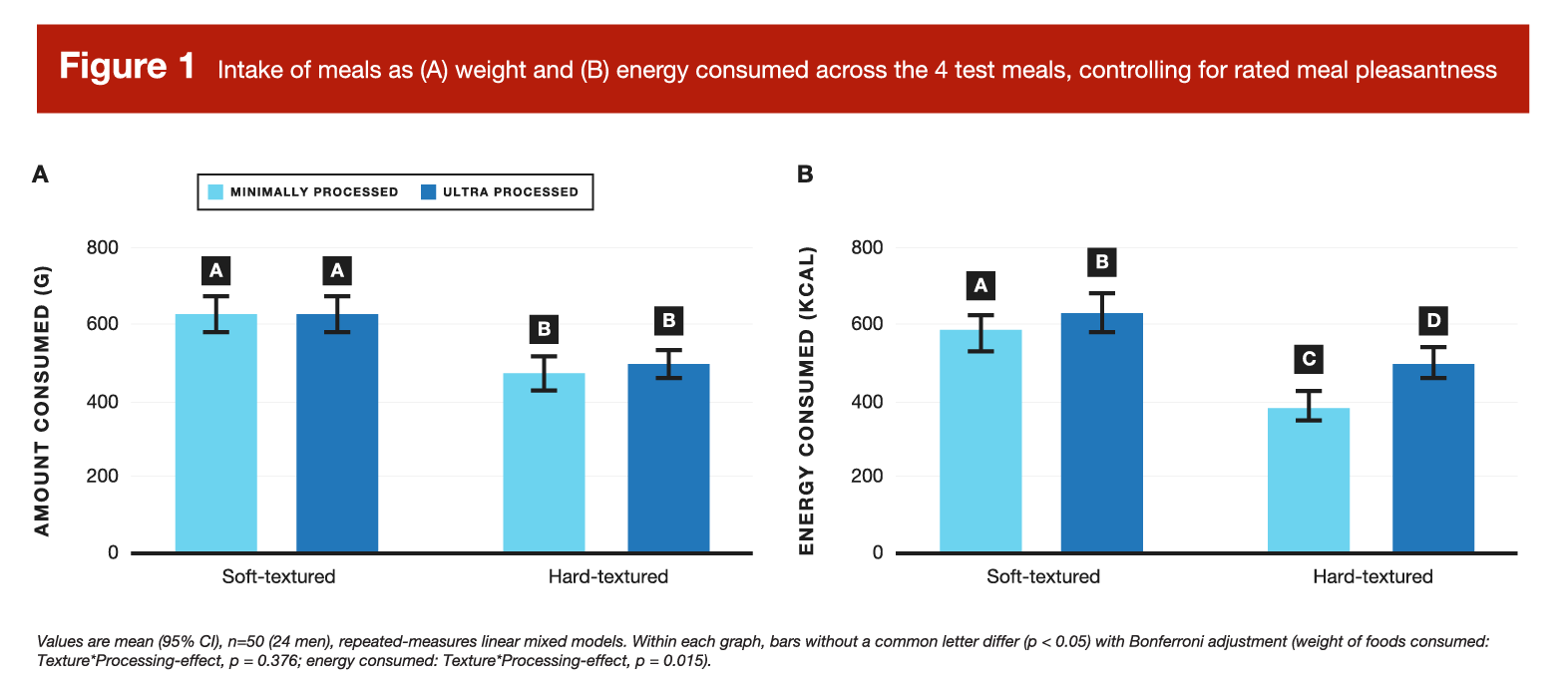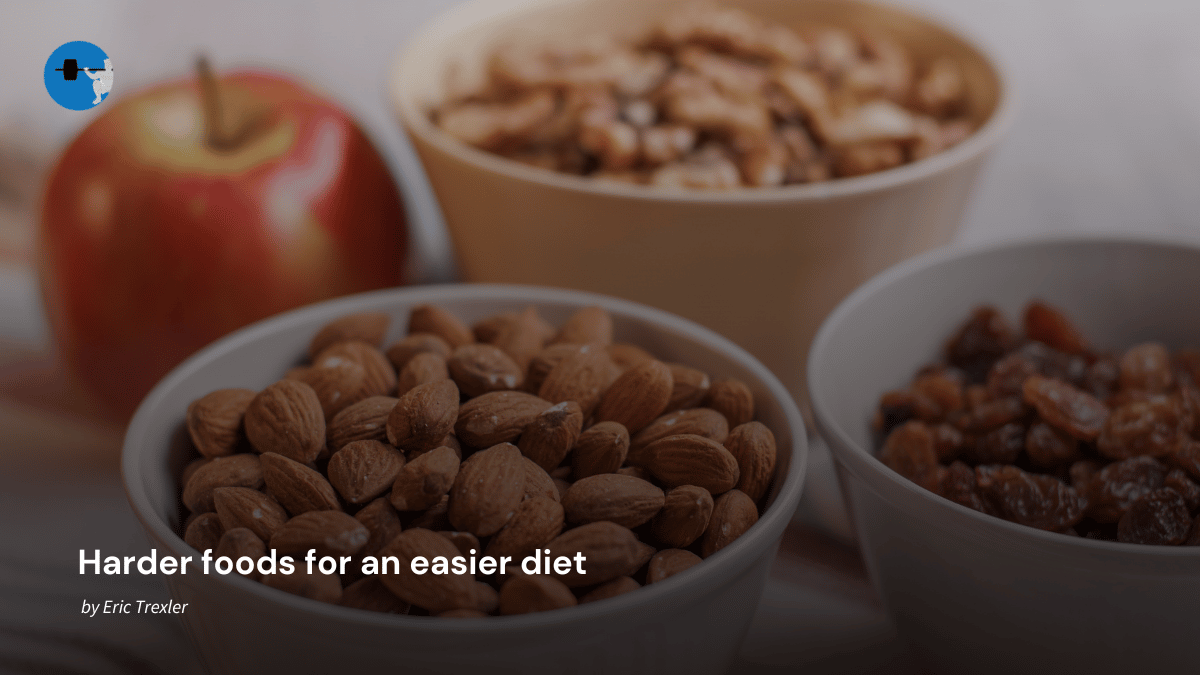The Paleo diet unnecessarily excludes plenty of foods based on the appeal to nature fallacy. However, vocal Paleo proponents often bring attention to one observation that is hard to dispute: the modern food environment tends to be quite obesogenic, and the foods we see in certain grocery store aisles are quite different from foods we might have encountered as a hunter-gatherer. We have unprecedented access to foods of varying texture, mouthfeel, flavor, and energy density, with food options ranging from entirely unprocessed to ultra-processed. The Paleo approach is to avoid all food sources that have been made possible by the food science advancements of the last few thousand years, a strategy that strikes me as a bit heavy-handed, as it might not necessarily be ideal for comprehensive micronutrient coverage, and it promotes a degree of rigid cognitive restraint that I consider excessive.
An alternative approach is to seek a deeper understanding of how various processing methods influence eating habits, and how various food characteristics impact satiety regulation, hedonic aspects of eating behaviors, and energy balance. Over the years, our research review MASS has covered a wide range of related topics, such as hedonic aspects of food intake regulation, the impact of food processing on energy intake, the relationship between energy density and energy intake (one, two), the relationship between certain macronutrients and satiety, and the effects of certain foods and beverages on satiety. At a basic level, these lines of inquiry equip us with more knowledge about how to navigate the modern obesogenic food environment in an informed manner, without needing to lean on excessively restrictive rules and guidelines. Taken one step further, they give us clues about how to construct a diet that makes body weight manipulation a little bit easier.
For example, someone struggling to gain weight can leverage these different food and meal characteristics to create a diet that uses palatable meals to provide plenty of calories without extinguishing their appetite. Conversely, someone struggling to lose weight (or maintain a reduced body weight) can use this information to design a diet that maximally promotes satiety on a tight calorie budget, while avoiding foods or meals that may provoke the desire for overconsumption. In short, we’re looking for relatively easy ways to passively support our likelihood of successful body composition manipulation, or (at minimum) avoid dietary choices that make an uphill battle even harder.
One food characteristic that we haven’t spent much time discussing is texture (hard versus soft). Fortunately, a new study provides some simple and practical guidance regarding the influence of food texture on energy intake. The presently reviewed study utilized a crossover design with 50 participants (48% male; 24.4 ± 3.1 years old; BMI = 21.3 ± 1.9 kg/m2) who had BMI values between 18.5 and 24.9, were not pregnant, were not actively trying to lose weight, and were not using any medications known to affect appetite or energy metabolism. Each participant consumed four different ad libitum test meals on four separate occasions, with each of the meals differing based on the texture and the degree of processing. The four meals included: 1) soft-textured and minimally processed; 2) soft-textured and ultra-processed; 3) hard-textured and minimally processed; 4) hard-textured and ultra-processed.
On the day of each laboratory visit, participants broke their overnight fast with a standardized breakfast four hours before the test meal. Participants also received a standardized mid-morning drink two hours before the test meal, which was consumed at lunch time. Participants were given each meal with 250mL of water, and food portions were matched for total energy among all four test meals. Participants were given 20 minutes to eat, and instructed to eat until they felt “comfortably full.” Subjects completed a number of questionnaires related to outcomes like appetite and sensory ratings of each meal, but primary outcomes of interest included the mass of food eaten in the test meals (in grams), the amount of energy consumed in the test meals (in kcals), and the amount of energy consumed in subsequent meals (after each test meal).
The highlights of this study’s findings are pretty straightforward and intuitive. Looking at the mass of food consumed (in grams), soft-textured meals led to significantly greater food intake than hard-textured meals (Figure 1). This was facilitated by a faster eating rate (grams of food consumed per minute), which was highest in the soft + ultra-processed meal, lower in the soft + minimally processed meal, and lowest in the hard-textured meals. Looking at the amount of total energy consumed (in grams), both texture and processing were quite impactful. Energy consumed was highest in the soft + ultra-processed meal, followed (in order) by soft + minimally processed, hard + ultra-processed, and hard + minimally processed (Figure 1). The same pattern was observed for the rate of energy intake (kcal/min) in each test meal. Despite greater energy intakes in the softer and more highly processed meals, post-meal satiety ratings were not significantly different among the four different test meals, and energy intake in subsequent meals was not significantly impacted. In other words, participants did not feel significantly more full after the higher-calorie meals, nor did they compensate for lower-calorie meals by eating more later in the day.

The results of the presently reviewed study line up nicely with the results of a study reviewed by Dr. Helms back in Volume 3 of MASS, while also taking the findings a step further. The previous study by Hall and colleagues found that, in very tightly controlled conditions, participants ate significantly more food mass and total energy on an ultra-processed diet when compared to a less-processed diet. While more total food and energy was consumed, satiety levels did not significantly differ between the diets. Eating rate was also significantly faster in the ultra-processed diet condition, which led Hall and colleagues to speculate that “Perhaps the oro-sensory properties of the ultra-processed foods (e.g., softer food that was easier to chew and swallow) led to the observed increased eating rate and delayed satiety signaling thereby resulting in greater overall intake.” Hall and colleagues also acknowledged that higher energy density of foods presented in the ultra-processed diet condition may have played a role in promoting higher total energy intake.
These insights about eating speed are informative and useful, but not exactly new. As reviewed by Forde, several studies have suggested that a slower eating rate can passively reduce ad libitum energy intake, with a 20% change in eating rate impacting energy intake by up to 10-13%. While Forde acknowledges several ways to promote a slower eating pace, alteration of meal texture (soft versus hard) is one of the more promising strategies discussed in their review. While slower eating rates could potentially reduce energy intake by allowing more time for satiety-related hormone responses after meal initiation and influencing outcomes related to attention and memory during and after the meal, harder meal textures may also influence energy intake by impacting the sensory experience of eating. A harder meal texture often involves more time spent chewing, which increases our sensory exposure to the flavors and aromas of the food. This is also true when it comes to minimally processed food options, which tend to have different textural characteristics than their highly processed counterparts. We can drink a smoothie containing an apple far more rapidly than we can eat an apple; while the smoothie rushes by our taste buds in the blink of an eye with each large gulp of the drink, an apple takes time to chew, and our exposure to its flavor and aroma is substantially prolonged. As explained by de Graaf and Kok, this plays a large role in the consistent observation that solid foods tend to be more satiating (per calorie) than liquids.
Of course, there are exceptions to just about every rule, and soup is the major exception when it comes to the low satiety levels commonly associated with liquids. Studies consistently report high satiety levels following soup consumption, and de Graaf and Kok argue that this observation is probably related to how we consume soup. It’s generally eaten with a spoon, which slows down the eating process, and this process can be slowed even further if the soup happens to be quite hot. In support of this hypothesis, they point to a fascinating study in which researchers compared satiety responses to eating an apple, drinking apple juice, or consuming apple juice with a spoon, as if it were a soup. While satiety ratings were higher for eating an apple than drinking apple juice, consuming the apple juice with a spoon increased satiety ratings to a level that was comparable with eating an apple.
This observation reinforces a broader point about satiety that is very important: the fitness industry is all too eager to provide oversimplified “fullness hacks,” but satiety is complex and multifaceted. The same exact food, prepared and eaten in different ways, can lead to substantially different satiety responses. While it’s tempting to oversimplify satiety recommendations by, for example, comparing one macronutrient versus another, we lose a lot of very useful nuance when we do that. It’s common for fitness professionals to field questions about which foods or which macronutrients promote satiety, and I’m increasingly convinced that these are the wrong questions to ask. We can say that “increasing protein” generally has a positive impact on satiety, but we can’t delude ourselves into thinking that a very palatable whey protein beverage is the same as an isonitrogenous boiled chicken breast when it comes to appetite regulation. Rather than focusing exclusively on food sources or macronutrients, we should probably be focusing on a broader set of characteristics associated with satiety responses to a given meal.
In my most recent MASS article about satiety and appetite regulation, I concluded that: “Some practical strategies that may support higher satiety levels during energy restriction involve eating more slowly, avoiding hyperpalatable meals, and structuring your meals with high protein, fiber, and water content, low energy density, and plenty of unprocessed or minimally processed foods.” I also mentioned that adopting an acceptance-oriented approach to hunger can be a very valuable tool while dieting. The presently reviewed study, and the related literature we’ve covered in this research brief, suggest that we can add a couple of extra tools to the satiety tool box. Evidence suggests that incorporating some harder food textures into our diet may passively encourage slower eating rates. In addition, if mechanisms related to attention, memory, and the sensory experience of the meal are truly driving a portion of the relationship between slower eating rates and lower energy intake, then we can probably maximize these effects by eating more mindfully, avoiding distractions while eating, and taking time to savor the aromas and flavors of our meal. In summary, there are several practical dietary modifications that can increase (or decrease) satiety, but there’s a lot more involved than trading one macronutrient for another.
Note: This article was published in partnership with MASS Research Review. Full versions of Research Spotlight breakdowns are originally published in MASS Research Review. Subscribe to MASS to get a monthly publication with breakdowns of recent exercise and nutrition studies.




